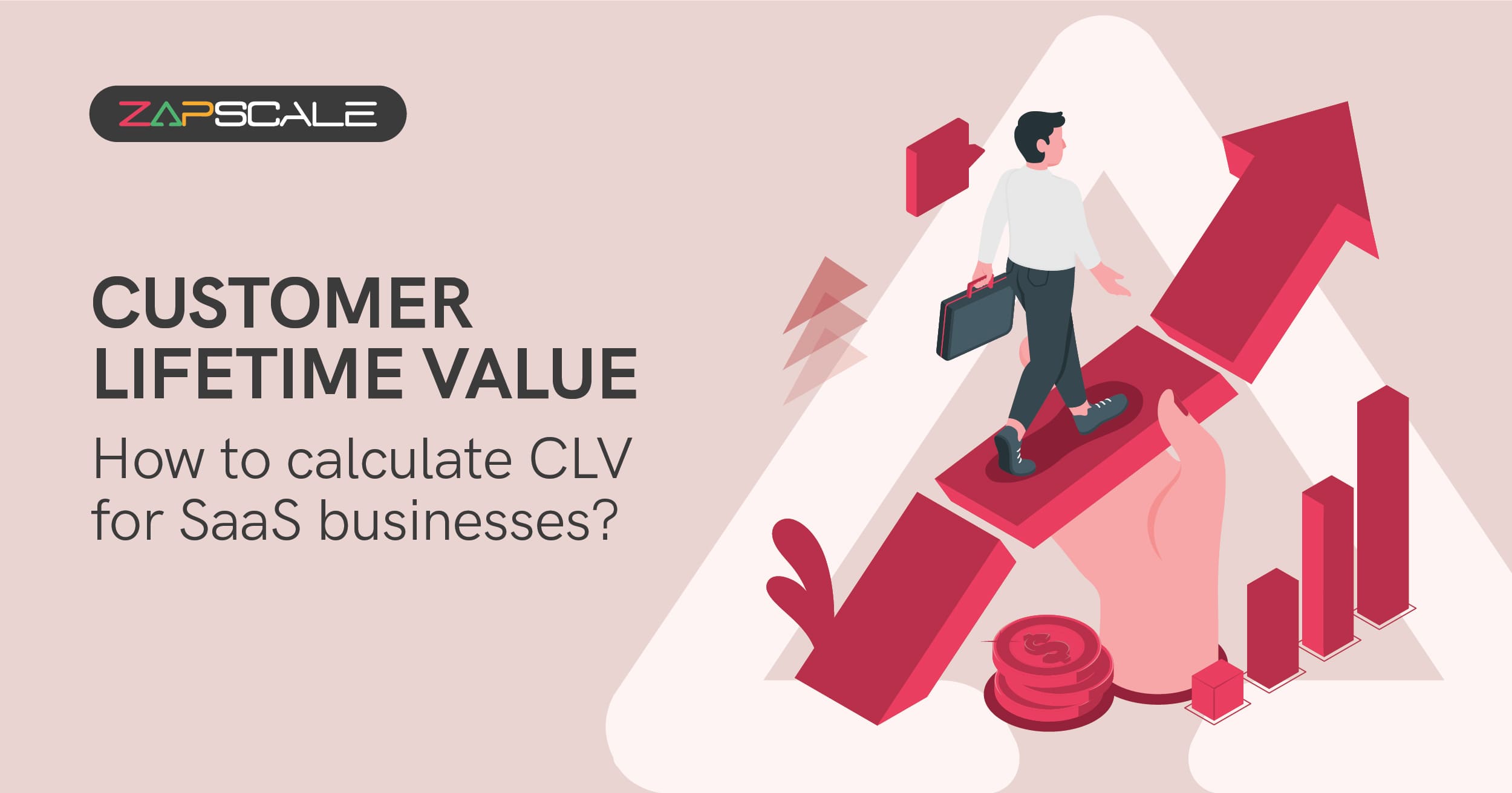CATEGORY > Customer Lifetime Value
What is Customer Lifetime Value? How to measure it?

Understanding and optimizing customer relationships are key to success in the dynamic business world. Customer Lifetime Value (CLV) is a helpful metric that helps businesses gauge the long-term value of their customers.
In this comprehensive guide, we will discuss the concept of Customer Lifetime Value, its calculation, and its significance in driving informed business decisions. Let’s start with understanding ‘what is customer lifetime value’.
What Is Customer Lifetime Value?
Customer Lifetime Value is a critical metric for SaaS businesses aiming to maximize profitability and customer satisfaction.
It represents the total revenue a business can expect to generate from a single customer account throughout its entire life cycle.
Key points to understand CLV
- Customer Lifetime Value quantifies the net profit attributed to the entire future relationship with a customer.
- It helps SaaS businesses understand the long-term value of their customers, guiding marketing strategies and investment decisions
- Calculation of customer lifetime value can be done by using this formula :
CLV = ( Average purchase value) x (Purchase frequency) x ( Customer lifetime)
Benefits of customer lifetime value
- By understanding CLV, businesses can tailor their interactions to drive customer loyalty.
- Focuses efforts on retaining and nurturing high-value customers, boosting overall revenue.
- Provides data-driven insights for making informed business decisions
Understanding and optimizing customer lifetime value is essential for sustainable business growth and long-term success. By focusing on this metric companies can better allocate resources, enhance customer experience, and ultimately drive profitability.
Why Is CLV Important To Your Business Growth?
1. Saves Money
Customer lifetime value is a crucial metric because retaining customers costs less than acquiring new customers. Focusing on existing customers boosts growth and reduces acquisition costs.
2. Spot And Stop Attrition
CLV helps you identify early signs of attrition. Declining CLV can indicate issues like missed subscription renewals. It improves loyalty programs, support, and marketing around renewal times.
Find Your Best Customers And Replicate Them
High CLV customers share common characteristics and you can analyze these traits to create detailed customer segments. Develop buyer personas to attract similar high-value customers. Also, predicting CLV helps you secure future revenue streams.
What Are The Benefits of Calculating Customer Lifetime Value?
Understanding the customer lifetime value calculation offers several benefits to businesses:
Utilizing CLV Measurements for Strategic Customer Prioritization
Measuring Customer Lifetime Value (CLV) offers a strategic advantage by shedding light on where your customer-centric efforts should be concentrated. CLV analysis can unveil disproportionate sales efforts allocated to leads and existing customers. By comprehending the varying values of different customer accounts, you can segment and prioritize the most valuable ones, optimizing your sales team's allocation of time and resources.
For instance, consider Customer A with a $100,000 CLV and Customer B with a $1 million CLV. Armed with this insight, your customer success department can make informed decisions to channel more resources into nurturing and retaining high-value customers.
CLV as a Revelation for Underdeveloped Accounts
Measuring CLV can serve as a revelation in account management. What might initially appear as a mediocre account can, upon CLV calculation, reveal itself as significantly underdeveloped, harbouring untapped potential beyond your team's initial assessment.
Take, for example, Customer A, with only a few sporadic, small-batch sales. This customer may have flown under the radar, making minimal impact on the sales department's radar. However, once you compute the customer’s full potential over the expected relationship duration, it may emerge as one of the top 20% of your business's accounts. Armed with this newfound insight, you can strategically reconsider the account's development approach.
CLV as a Tool for Long-Term Planning
Leveraging CLV's predictive capabilities empowers you to tap into a company's market potential based on its existing accounts. This approach provides a comprehensive, multi-dimensional view of the company's growth possibilities.
Consider various strategies, such as calculating CLV for your entire customer base and strategic accounts, as well as segment markets by region. This data becomes invaluable in decision-making processes, especially when a customer's short-term value might be insufficient or potentially misleading. CLV allows you to make more informed, forward-looking decisions, paving the way for long-term planning and sustainable growth.
How to Calculate Customer Lifetime Value?
This formula requires two metrics:
Customer Value
Customer Value is calculated by multiplying the average purchase value by the average purchase frequency rate
Average Customer Lifespan
Calculated by averaging the time between the first time a customer bought something and the most recent time they bought something.
Or, you can use a more complicated formula that will give you a more accurate result. This formula is:
Below are a few metrics that are needed for this CLV formula:
Average Purchase Value
The average purchase value is calculated by dividing your company’s total revenue within a single period (let’s say in one year) by the number of purchases customers make throughout the year.
Average Purchase Frequency
Average purchase frequency is calculated by dividing the number of purchases in the period by the number of unique customers who made purchases during that period.
Average Gross Margin
The average gross margin is calculated by subtracting the cost of an average sale from the revenue gained from an average sale.
Strategies To Improve Customer Lifetime Value
To improve Customer Lifetime Value, businesses can adopt several strategies:
1. Enhance Your Onboarding
Experience Customer onboarding is the essential process of acquainting your customers with your product's purpose, significance, and reasons for their continued engagement. An effective onboarding experience is instrumental in enabling customers to derive value from your product.
2. Elevate Average Customer Value
Boosting your Customer average value is a strategic move. Continuously monitor your customers' usage patterns and identify opportunities for additional features or services that align with their needs. During renewal periods, proactively recommend upgrades tailored to their requirements.
3. Foster Long-Term Customer
Bonds Long-lasting customer relationships are rooted in trust. When customers perceive your product as valuable and instrumental in their personal and business growth, they are more inclined to remain loyal to your brand.
4. Embrace Valuable Customer Feedback
Listening can be more impactful than speaking. Customers often offer valuable insights on ways to enhance your business practices to better meet their needs. This not only makes them feel valued but also contributes to their overall satisfaction.
5. Empower Consistent Engagement
Establishing a robust engagement strategy is crucial. Staying connected with your customers and anticipating their needs before they articulate them is pivotal to ensuring customer satisfaction.
6. Elevate Your Customer Service
A staggering 90% of Americans consider customer service a key factor when selecting companies to do business with. Thus, to enhance your Customer Lifetime Value, dedicate efforts to refining your customer service and continuously seek opportunities for excellence.
Conclusion
Now that you know “what is customer lifetime value”, you might have also understood how helpful this can be for businesses to assess the long-term value of their customers and make informed decisions.
By understanding the components of CLV and adopting strategies to enhance it, companies can build lasting customer relationships, drive profitability, and achieve sustainable success in the competitive marketplace.
Zapscale, a leading customer success platform, plays a crucial role in this process by providing valuable data and key performance indicators (KPIs) to help businesses improve their customer lifetime value. By leveraging the insights provided by Zapscale, companies can gain a deeper understanding of customer behavior, preferences, and interactions throughout their lifecycle.
FAQs
1. What is customer lifetime value?
Customer lifetime value is a metric that represents the total revenue a business can generate from a single customer over its entire life cycle.
2. Why is CLV important for my business?
Customer lifetime value is important for your business because it helps you reduce customer acquisition costs by focusing on retaining existing customers. It identifies high-value customers for targeted marketing and provides insights for improving customer retention and loyalty programs.
3. What tools can help you analyze and measure CLV?
Several tools and software can help measure and analyze customer lifetime value, such as CRM systems ( Salesforce and HubSpot), data analytics platforms ( Google Analytics, Tableau), and specialized CLV calculators available online. These tools provide insights into customer behavior, that helps businesses make data-driven decisions to enhance CLV.
ABOUT THE AUTHOR
Popular from Customer Lifetime Value
Quality Content,
Straight To Your Inbox!
Subscribe for the latest blogs, podcasts, webinars, and events!

Write a Blog
If you have experience in CS and
a flair for writing, we’d love to
feature you.
Write to us on
hello@zapscale.com



